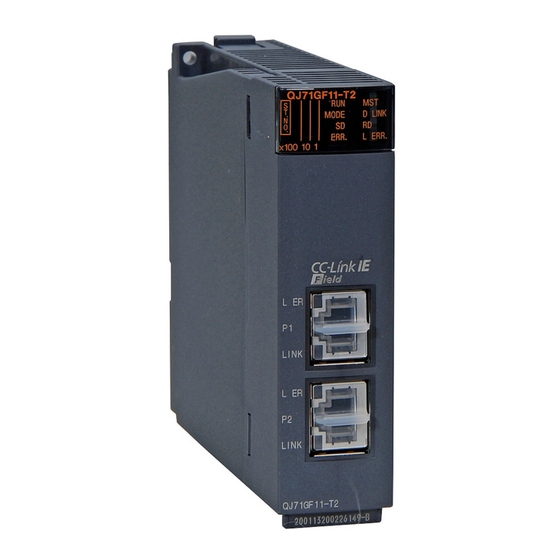
Mitsubishi Electric QJ71GF11-T2 Manuals
Manuals and User Guides for Mitsubishi Electric QJ71GF11-T2. We have 1 Mitsubishi Electric QJ71GF11-T2 manual available for free PDF download: User Manual
Mitsubishi Electric QJ71GF11-T2 User Manual (569 pages)
MELSEC-Q series CC-Link IE Field Network Master/
Local Module
Brand: Mitsubishi Electric
|
Category: Controller
|
Size: 32.98 MB
Table of Contents
-
Term18
-
Packing List21
-
-
-
-
Precautions56
-
-
-
-
-
-
Wiring70
-
-
-
-
Link Refresh129
-
-
-
Accessible Range160
-
-
Program Example197
-
Automatic Switch201
-
Manual Switch202
-
Diagnostic Items208
-
-
Link Start/Stop223
-
-
-
Remote Operation236
-
-
-
Channel243
-
-
-
Data Types248
-
-
Setting Data250
-
Control Data251
-
Function254
-
-
-
-
-
-
REQ Instruction326
-
Target Stations326
-
-
-
Parameter Error365
-
-
-
-
-
-
-
-
-
-
Error Code List441
-
Appendices466
-
-
-
Buffer Memory539
-
IP Address545
-
Debugging546
Advertisement
Advertisement
Related Products
- Mitsubishi Electric MELSEC QJ71GP21-SX
- Mitsubishi Electric MELSEC QJ71GP21S-SX
- Mitsubishi Electric QJ71C24N-R4
- Mitsubishi Electric Melsec QJ71LP21
- Mitsubishi Electric Melsec QJ71BR11
- Mitsubishi Electric QJ71NT11B-U-HW
- Mitsubishi Electric Melsec QJ71PB92V
- Mitsubishi Electric Melsec QJ71PB92U
- Mitsubishi Electric Melsec QJ71PB92SY
- Mitsubishi Electric Melsec QJ71PB92E
